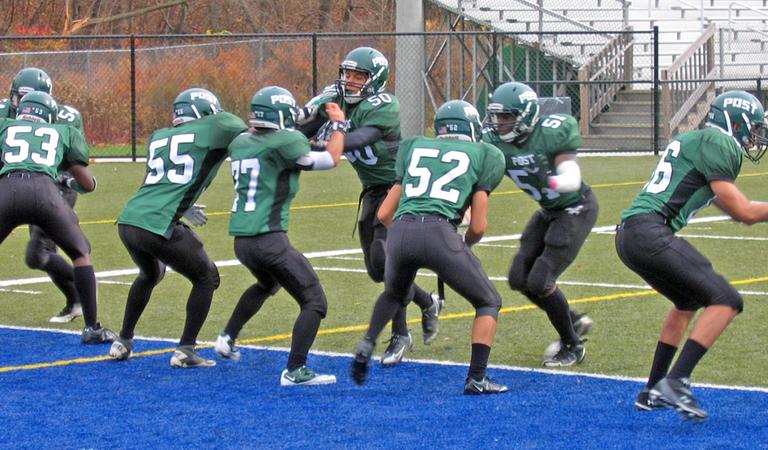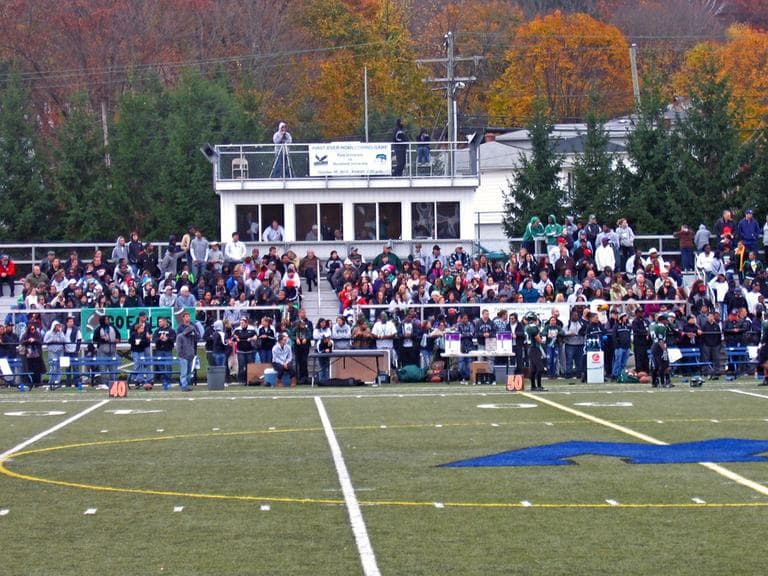Advertisement
Bodies Smaller, But Hearts Just As Big, In Sprint Football
Resume
On a crisp, clear October Saturday, in Waterbury, Conn. — a perfect day for football — Post University hosted Mansfield University of Pennsylvania.
As game time approached, the parking lot at Municipal Stadium was full and some Post fans were still tailgating. Inside the stadium, the crowd was ready for its first taste of sprint football.
In today’s major college football programs it’s not hard to pick out the linemen. Just look for the guys who are 300 pounds, or pretty close to it. But in sprint football, it’s not uncommon to see a running back standing shoulder to shoulder with a defensive tackle. That’s because sprint players have to weigh 172 pounds or less — all of them. Otherwise, the game follows regular NCAA football rules.
Mansfield linebacker Eli Morgan says he and his teammates still get a lot of questions about their sport from fellow students.
“They don’t understand that it’s all the same football, just the weight restriction," Morgan said. "They’re always asking, ‘Is it flag football? Is it touch football?’ And you just have to explain to them, everything’s the same, just the kids are a lot smaller.”
The Collegiate Sprint Football League, or CSFL, was founded as the Eastern 150-Pound Football League in 1934. The weight limit has been raised several times since, to keep up with the average size of male college students. For many years, the sport was known as “lightweight football.”

“The way regular college football has kind of morphed, size is quite important,” said Cornell University Associate Director of Athletics and CSFL Commissioner Steve Erber. "This enables these young guys that have been high school football players, but aren’t big enough to play in college, including a Division III college, to play another four years of football, which I think is just a terrific thing.”
To play in CSFL games, athletes must successfully weigh-in on Monday and again on Wednesday before a Friday game. Players cannot use saunas or other drastic measures for dropping weight and have to pass hydration tests. They’re also required to have at least 5 percent body fat.
There are small players who don’t have to worry about the weight limit, but bigger players like Post tight end Rashaun Reid do.
“The challenge was getting [to] 172 [pounds]," Reid said. "I was 180, 185.”
When asked what players do to make weight, Reid and Post center Chris Masayda respond simultaneously with a laugh, “Work hard.”
“Lift, a lot of dieting,” Masayda continued. “I was in high school, I graduated 2009. I weighed 210 pounds and I was off for two years. And so I just worked hard, got down to the weight and came and played here.”
Despite a nearly 80-year history, sprint football has remained small –- pun intended. The CSFL has seven teams: Cornell, Penn, Princeton, Army, Navy, Mansfield, and Post. The league requires schools to treat the sport as a varsity –- not club -– sport and squads play six or seven games per season.
Post University co-captains Lee Knight and Kyle Lagasse both played regular football at other small colleges during their freshman years, but transferred to Post even though the school did not have football at all.
Knight says when Post added sprint it gave them one more, unexpected chance to play.

"I was at the point where I thought my football career was over," Knight said. "And then being able to have the opportunity again … I guess I can say it's emotional for me. It felt great. I love the sport."
Lagasse agreed.
“I thought I was done," Lagasse said. "I was going to school and I was working. And this came up and I was like, ‘Hey, I have the rest of my life to work. What’s another three years of football? It’s going to be fun.’”
Other than the size difference, quickness is what sprint coaches and players talk about most.
Post head coach Pete Ewald played football at Syracuse University in the 1980s and has also coached in traditional programs.
“My quarterback this year put it in real good perspective," Ewald said. The player told him "You know, in high school, I could run away from the linemen. In this league I can’t run away from the linemen because they’re just as fast as me."
That every player is quick can make the transition to sprint football tough for some players, Ewald said.
“That is probably, in a nutshell, the biggest thing players have to adjust to," Ewald said. "They can’t run away from people because everyone’s basically the same speed.”
Post University’s game against Mansfield was an historic moment for the Eagles. It was the first football team Post ever fielded in its 120-year history. The Eagles played a shortened schedule before becoming a full CSFL member next season. The game against Mansfield was Post’s first home game and their final game of the season.
As the game began, the bleachers behind the Post bench were packed. The announced attendance was 1,007 and the crowd got its first Eagles highlight on the opening kickoff. Mansfield fumbled and the Eagles recovered deep in Mountaineers territory.
Among the fans in attendance were students Greg Guerrier and Yardley Marcelin. It was obvious that they were ready for some football: they’d both painted their faces green and their hair white, Post’s school colors.
“It’s very exciting," Guerrier said. "The players are really good. They’re doing as best as they could."
“Everything goes by so fast because they’re so small,” Marcelin added, laughing.
Here in Waterbury, Conn. Post University sprint football is off to a strong start, but the school where the sport means the most might be Mansfield.
The small university in Pennsylvania had a Division II football program for 115 years before dropping it after the 2006 season for financial reasons. The sprint program was established in 2008 and Mansfield now draws 2000 to 3000 fans per home game.
Army Sprint Football Head Coach Lt. Col. Mike McElrath played on Army’s regular team in 1990s. He says at West Point and other schools with two football programs, sprint will always be overshadowed, but at Mansfield — and now Post — it’s the main event.
“We have our fan base that we get for our home [sprint] games, but when we went to Mansfield it was everything you’d expect at a college football game,” McElrath said. “The sprint team is the Mansfield football team. The band is there, cheerleaders. It was by far the most well-attended game that we played this season. It’s a game day experience.”
In the second quarter, Post scored first, but the Mountaineers quickly pulled ahead. The Eagles kept things lively with two near-miss chances to take the lead in the final minutes, but in the end, Mansfield came out on top 7-6, spoiling Post’s inaugural home opener.
Mansfield’s running game looked strong and Post connected on some excellent passes, but the teams also showed their inexperience, combining for 20 penalties and 13 turnovers, and generating the lowest point total of any sprint game this season.
But Mansfield Sports Information Director Steve McCloskey says it will take more than one sloppy game to dampen either team’s enthusiasm.
“We have some kids here that are 5’2” and 5’3” and 140 pounds and even in the sprint world that’s small, that’s really small," said McCloskey, who was instrumental in bringing sprint to Mansfield. "But they’re on that kickoff team and when that ball is kicked off that kid is running down that field and in his mind, he doesn’t know he’s 5’2” and 5’3.”
“He thinks he’s 6’5” and 240 pounds and he’s running down in a major college football game. And shouldn’t we all be able to have that thrill of being able to think that way? It’s great.”
This story originally aired on Only A Game.
This program aired on November 6, 2010.
